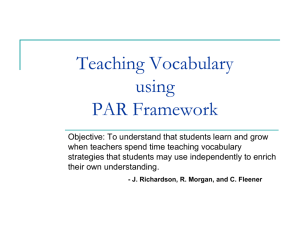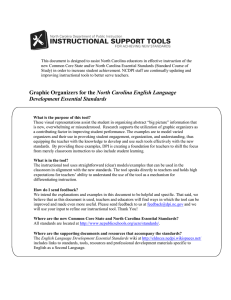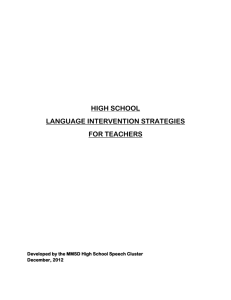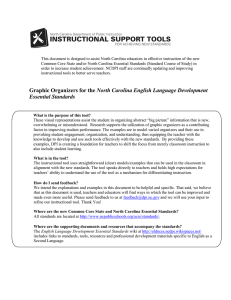Literacy Classroom Operational Protocol Document Instructional Practices (Teacher) Provides
advertisement
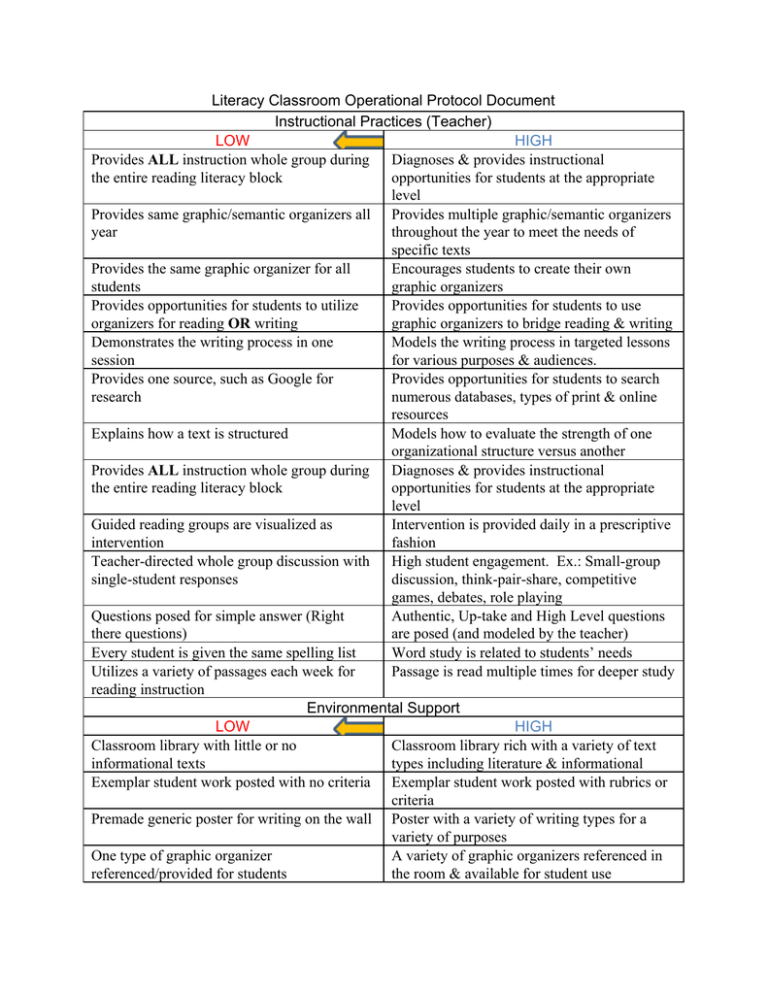
Literacy Classroom Operational Protocol Document Instructional Practices (Teacher) LOW HIGH Provides ALL instruction whole group during Diagnoses & provides instructional the entire reading literacy block opportunities for students at the appropriate level Provides same graphic/semantic organizers all Provides multiple graphic/semantic organizers year throughout the year to meet the needs of specific texts Provides the same graphic organizer for all Encourages students to create their own students graphic organizers Provides opportunities for students to utilize Provides opportunities for students to use organizers for reading OR writing graphic organizers to bridge reading & writing Demonstrates the writing process in one Models the writing process in targeted lessons session for various purposes & audiences. Provides one source, such as Google for Provides opportunities for students to search research numerous databases, types of print & online resources Explains how a text is structured Models how to evaluate the strength of one organizational structure versus another Provides ALL instruction whole group during Diagnoses & provides instructional the entire reading literacy block opportunities for students at the appropriate level Guided reading groups are visualized as Intervention is provided daily in a prescriptive intervention fashion Teacher­directed whole group discussion with High student engagement. Ex.: Small­group single­student responses discussion, think­pair­share, competitive games, debates, role playing Questions posed for simple answer (Right Authentic, Up­take and High Level questions there questions) are posed (and modeled by the teacher) Every student is given the same spelling list Word study is related to students’ needs Utilizes a variety of passages each week for Passage is read multiple times for deeper study reading instruction Environmental Support LOW HIGH Classroom library with little or no Classroom library rich with a variety of text informational texts types including literature & informational Exemplar student work posted with no criteria Exemplar student work posted with rubrics or criteria Premade generic poster for writing on the wall Poster with a variety of writing types for a variety of purposes One type of graphic organizer A variety of graphic organizers referenced in referenced/provided for students the room & available for student use Random word walls Word walls related to patterns, roots, vocabulary Instructional Application (Students) LOW HIGH Look up a word in the dictionary/thesaurus for Utilize dictionary/thesaurus skills to gain the spelling/synonym/definition information such as correct usage of multiple meaning words & learning the word’s origination Use an encyclopedia Compare the encyclopedia to other sources & evaluate them Locate a source on a topic Compare multiple sources and evaluate their credibility Cite works or create a bibliography Defend the choice of sources for the research Answer question/discussing text without the Students referencing text and providing text available evidence for their responses Use a word correctly from a text Evaluate the author’s use of words to convey the desired meaning Identify word patterns & roots Apply patterns & root meanings to determine the meanings of new words Practice skills/complete assignments without Able to understand & communicate the goal knowing the goal for the skills/assignment Comprehension strategies are utilized but Understand the purpose behind the students do not have a clear purpose comprehension strategies they are applying Comprehension is random without clear Comprehension is monitored by the student consciousness by the students who is conscious of his/her understanding Text is referenced, but answers do not reflect Elaborated explanations and Exploratory talk analysis or evaluation leads the student discussion Only teacher/text provided questions are Questions are asked by the students as they considered read One strategy is used to build comprehension Several strategy procedures are used while reading Texts/passages are read without student notes Annotations are used to aid with their working memory (on the text, another paper or sticky notes) Writing occurs daily with student choice Writing about literature occurs regularly Book talks are led by teacher Book talks are led by students Environmental Support LOW HIGH Vocabulary for the week on the board Word walls related to patterns, roots, vocabulary Computers in the classroom or library Databases provided Teacher is the resource Learning community that searches for resources before asking for answers Silence Enthusiastic student conversations Teacher lectures and students take notes Rich oral language is heard and used by teacher and students

